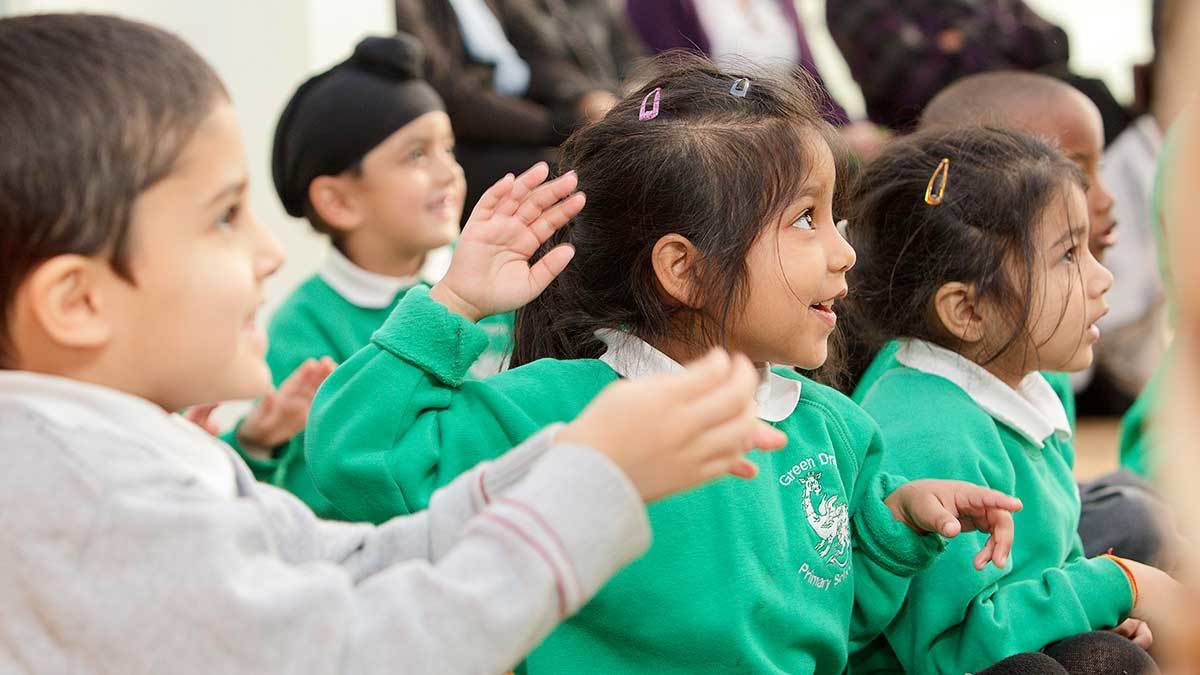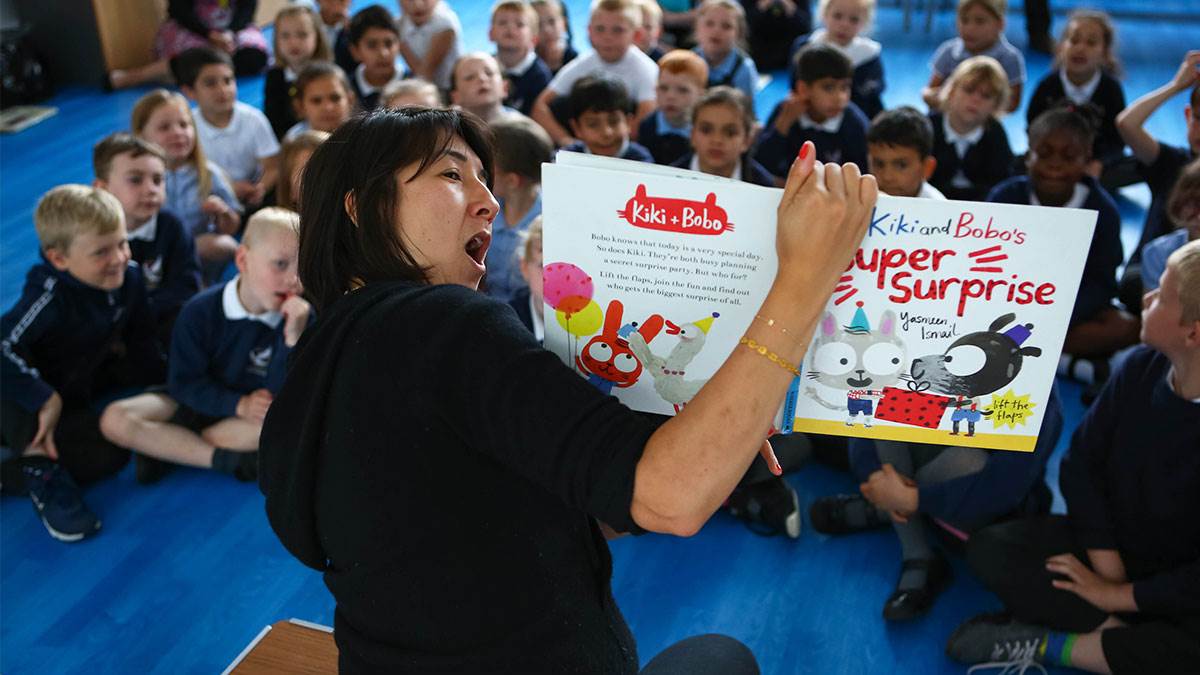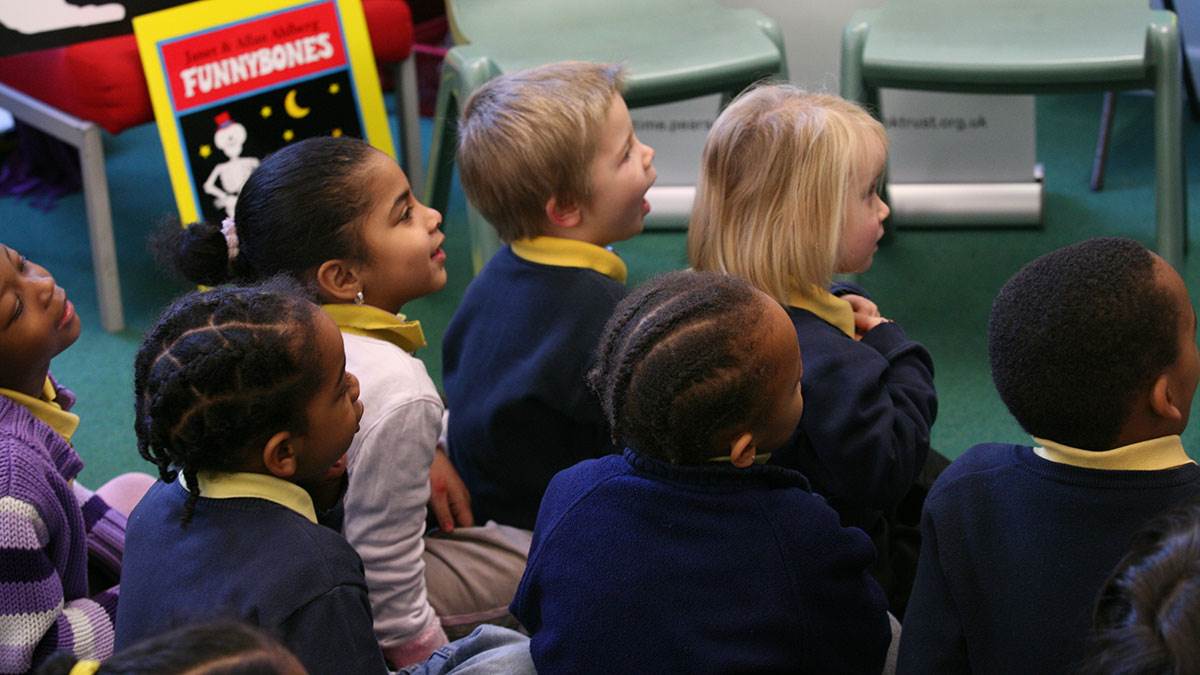How to read aloud to a classroom
Published on: 11 January 2024
We at BookTrust know the benefits of reading for pleasure, and that one of the best ways to motivate children to read for fun and gain access to these benefits is for a reading role model or ‘reading influencer’ to read aloud with children. We talked to education consultant Rachel Clarke about how teachers can engage their class by reading aloud to them regularly.
 Primary children in a classroom
Primary children in a classroom
Reading aloud is one of the best ways we can ensure children become readers.
Long before they can read the words on a page for themselves, we can spark their imaginations, take them on journeys to other worlds, and introduce them to characters they will love.
Reading aloud also allows us to share vocabulary and sentence structures that children may not hear in their everyday lives. It enables us to model expressive reading. And it allows us to create shared memories of listening and talking together about a book that we have enjoyed.
Reading aloud is an activity where neither teachers nor pupils feel pressured to meet a target. Instead, reading aloud creates a time and space with pleasure at its heart.
For English subject leaders looking to embed reading aloud in their school, there are a few considerations to make and share with their colleagues.
1. Choosing your read-aloud text
Stocking your book corner with books by an author and choosing one of these to read aloud to the class is a great way to build children’s reading habits. It’s also a good way to build familiarity with the stock in your book corner so that children are more likely to read it. BookTrust’s Great Books Guide includes books by several authors that you could do this with. Similarly, choosing to read a book from the beginning of a series, and including other books in your book corner is a good way to hook readers. And remember, you don’t have to read the whole book. You could choose to read part of the book, stop at a point of tension and suggest that the children read the book themselves to find out what happens next.
The Great Books Guide categorises books by age group so you can be confident that the content is suitable to your class. The books have been read by experts in children’s literature and so are likely to appeal to your children. They cover a range of genres and topics, including popular curriculum links, and are authentically representative; meaning every child in your class should be able to see themself reflected in the books and poems. Whether you are looking to thrill your class, to make them laugh, or make them cry, there is something perfect to read aloud in the Great Books Guide.
 Author Yasmeen Ismail reads to a primary class
Author Yasmeen Ismail reads to a primary class
2. Read the book first
It can be tempting to share a book with the children without reading it first. However, this can be risky. You may find the book doesn’t read aloud well, perhaps because it contains long complicated sentences or is in a comic book format that makes it tricky to share.
It could contain themes and events that are unsuitable for your children, or you may find it just doesn’t appeal to your class.
Reading the book before you share it with the class enables you to plan how to read it – to think about character voices and actions you may use. And to consider where you need to read at pace, where you should linger, where your intonation should rise and where you need to drop your voice to a whisper to create awe… wonder… suspense…
Pre-reading alerts you to the breadcrumb trail that the author has laid throughout the text. This helps you ask those light-touch ‘I wonder if…’ style questions that help children ponder the author’s intentions and to predict the path of the narrative rather than the formal reading comprehension-style questions that can break the spell of the read-aloud session.
3. During reading
It’s worth spending time thinking about how to make the read-aloud session as pleasurable as possible. Not all classrooms have carpets and cushions for children to sit on as they are immersed in their daily read aloud. But asking for quiet (apart from when you want the children to join in), asking for tables to be cleared, and turning off any screens and bright lights can help to create a cosy listening environment.
Build connections between you, the children and the book by making eye contact as you read. Putting your finger on the text as you look up will help you keep your place and avoid losing the flow of your reading.
If you’ve pre-read the text,you’ll know the high points of tension where the children are likely to groan when you finish reading. Leaving them wanting more will carry you and them to the next read-aloud session and may even tempt some of them to seek the text for their own reading because they simply cannot wait.
 Children listening to a story
Children listening to a story
While chapter endings may be the point at which you want to finish your daily read, they are often of different lengths and not all chapter endings leave the narrative dangling. Once again, pre-reading will help you to plan breaks to build anticipation and to fit the time you have available for reading.
Make time in the read-aloud session for comments. Encourage the children to talk about what they have heard. This could be their likes and dislikes, or anything that they’re confused about. You could even consider encouraging them to make connections between the book and others you’veshared, or they’ve read themselves.Encourage opinions and share your own, maybe collecting a few on sticky notes to add to a classroom display about the books you’ve shared.
4. Rereading
Consider rereading shorter books such as picture books and poems with your class. When the class have built a bond with a book, it’s like welcoming an old friend to storytime. They’ll delight in hearing it again, anticipating their favourite parts, and likely joining in with repeated words and phrases.
Rereading isn’t limited to short texts. When reading longer texts it can be effective to reread key passages or sections of text that emphasise plot points or that prompt thinking and discussion.
Whichever texts you choose to read aloud to your class, know that you are creating an association of reading with pleasure in their minds. And enjoy!
You might also like...
Check out our booklists for recommendations on what to read to your primary class.
Brilliant books to read to primary school children
Reading books to children has lots of amazing benefits - even when they're learning to read (or can read) themselves. We think you'll love sharing these great titles.
Stories to read out loud in Welsh and English / Storïau i'w darllen ar goedd yn Gymraeg a Saesneg
To celebrate National Storytelling Week in Wales, we’ve put together our favourite books that are best read aloud.
I ddathlu Wythnos Genedlaethol Adrodd Stori yng Nghymru, rydyn ni wedi llunio rhestr o’n hoff lyfrau sydd wych i'w darllen ar goedd (yn uchel).







